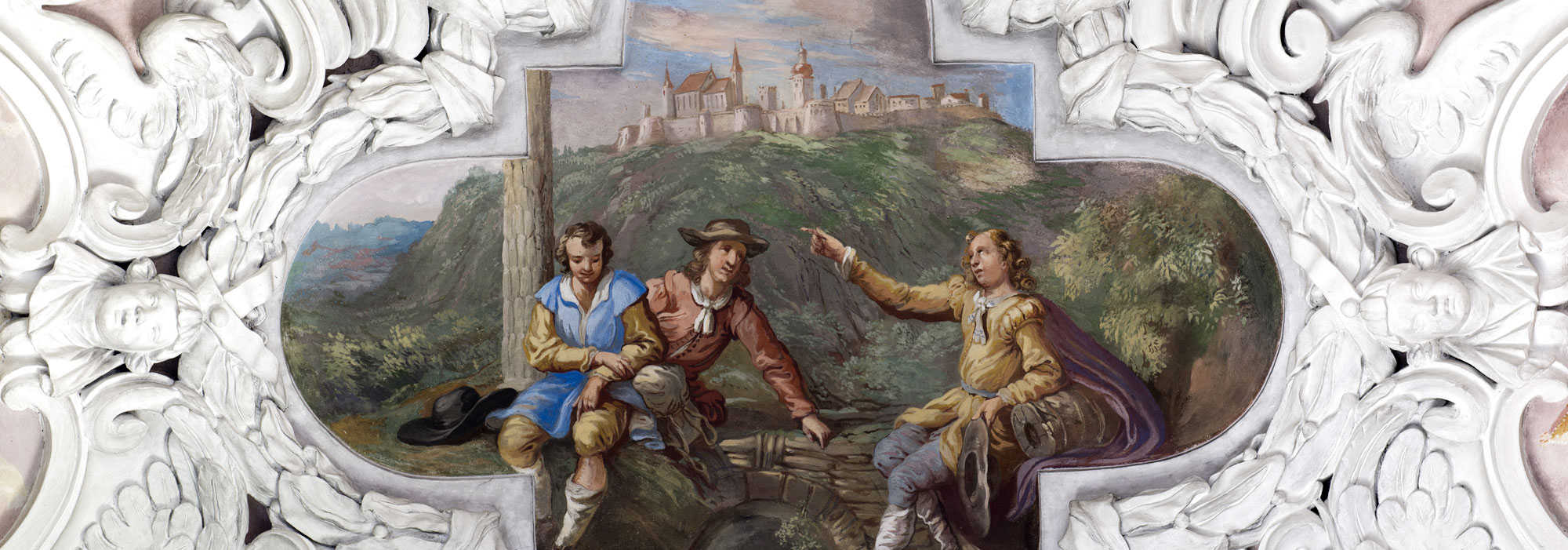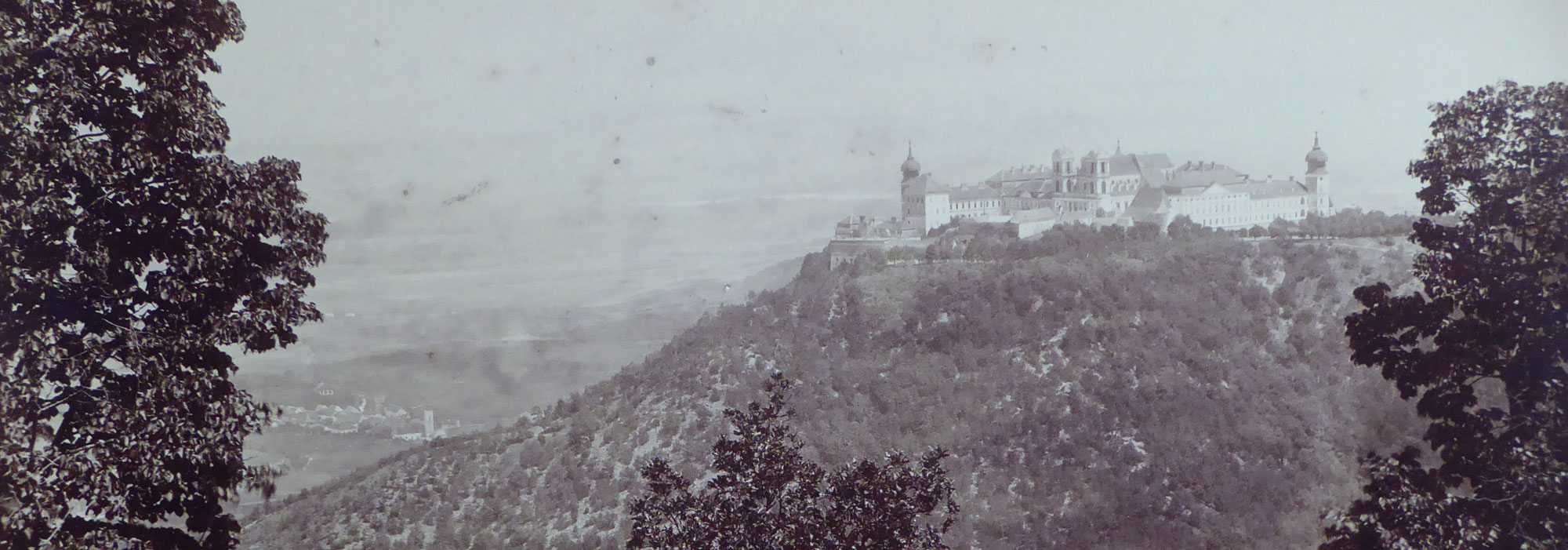
History of the monastery
Foundation
St. Altmann (1015/1020-1091), Bishop of Passau since 1065, founded Göttweig Abbey in 1083 as a double monastery, which lived according to the Rule of St. Augustine for eleven years and according to the Rule of St. Benedict from 1094.
| More about the foundation |
|
Bishop Altmann of Passau is the only bishop venerated as a saint in the former great diocese of Passau, whose territory included the present-day dioceses of Passau, Linz, St. Pölten and Vienna.
In 1072 Altmann consecrated the church of St. Erentrudis on Göttweig Mountain, where a wooden church of St. George had stood since the 9th century. He had received the Paudorf estate, which included the mountain, from the Formbach family from Radlberg, who were related to him, and had obviously previously been part of the large Salzburg estate, which stretched from the Arnsdörfer in the Wachau region via Wölbling to Traismauer.
In 1083 Altmann founded Göttweig Abbey as a double monastery, which lived according to the rule of St. Augustine for the first eleven years and adopted that of St. Benedict in 1094.
Altmann's main concerns were the renewal of faith and the reform of the clergy and monasteries.
Altmann vehemently supported the position of Pope Gregory VII (1073-1085) in the investiture dispute, which arose over the modalities of the appointment of ecclesiastical officials, as well as in the associated church reform. He was held in high esteem by him and his successors. He was papal legate for the empire for 15 years, from 1076 until his death.
On September 9, 1083, the feast of St. Gorgonius (patron saint of Gorze, the origin of a Benedictine reform movement favoured by Altmann), the bishop consecrated the men's monastery church to Our Lady. Although he had close ties to the Babenbergs - Leopold II had broken away from Henry IV on his account and had therefore been defeated by the Bohemians at Mailberg in 1082 - he entrusted the Formbachers of Radlberg, who were related to him, with the bailiwick of the monastery.
On August 8, 1091, Altmann died in the Passau court of Zeiselmauer, near Tulln, where Margrave Leopold II had his seat.
In order to lend stability to Göttweig, which had been founded as a monastery in Passau (an opposite bishop still ruled in Passau), it was converted into a Benedictine abbey after the death of Altmann, who was a great supporter of the canons' movement. The first abbot in 1094 was the prior of St. Blasien, Hartmann (+1114), who had previously been provost of St. Nikola and chancellor to the counter-king Rudolf and who, for reasons of church politics but completely against the ecclesiastical reform spirit of his time, was also abbot of St. Lambrecht in Styria, of St. Ulrich and St. Afra in Augsburg and of Kempten in the Allgäu.
The nave of the collegiate church and the recently uncovered foundation walls of the church of St. Blasien in Klein-Wien date back to Bishop Altmann's time.
The holy bishop is commemorated twice a year: on August 8, the day of his death, and on June 16, the day of his translation (Duke Rudolf the Founder had Altmann's remains raised and reburied in 1362). |
Middle Ages
The second major construction period followed in the 15th century, from which the crypt and choir of the abbey church, the choir of St. Blasien and the Gothic castle date.
| More about the Middle Ages |
|
Göttweig's importance increases rapidly. New monasteries are settled from here: Garsten in 1107 and Seitenstetten in 1116.
Around 1250, the nunnery, whose most important nun and founder was Duchess Gerbirg (+1042), a sister of Margrave Leopold the Saint, was relocated to Göttweiger Berg. The Inklusin Ava (+1127), the first female poet in the German language, is also said to have lived in its vicinity.
In 1382, the Göttweig abbot received the pontificals, and in 1401 the monastery was “exempted”, meaning that it was no longer subject to the bishop but directly to the Holy See.
The second major construction period began in the 15th century, much of which can still be seen today: the crypt and choir of the abbey church, part of the cloister and the castle as well as the choir of St. Blasien church.
From 1418, the monastery was renewed internally by joining the Melk Reform. Nevertheless, the number of monastery members continued to decrease, debts grew, the teachings of Martin Luther and other reformers brought confusion and helplessness, and the Turkish threat became ever greater.
After the death of Abbot Leopold Rueber in 1556, there was only one monk left in the house, the convent was at an end and was placed under the control of the provost of Herzogenburg, Bartholomäus a Cataneis. In 1557, he closed the women's convent, which still consisted of seven nuns, and moved it to St. Bernhard near Horn, where the last nun died in 1582. From 1508, this convent had a feminized Benedictine Rule in Middle High German, which was first printed in 1992.
The Göttweig convent was probably the oldest and longest existing women's convent of a Lower Austrian double monastery. Apart from the special case of Geras-Pernegg, the church of St. Blasien is the only surviving convent church of a double monastery in Lower Austria.
In 1564, the Benedictine Michael Herrlich (1564-1603) from Melk was appointed as the new abbot - today he is regarded as the second founder of the monastery. Despite economic hardship (monastery fire in 1580, Reformation period, plague, small number of monks), he saved the continuity of the monastery during his almost 40-year term of office. |
Baroque period
The Baroque period at Göttweig is linked with the name of Abbot Gottfried Bessel (1714-1749), the 50th Abbot of Göttweig. His greatest work was the rebuilding of the monastery, which had become necessary after the catastrophic fire of 1718.
| More about the Baroque period |
|
The imperial architect Johann Lucas von Hildebrandt provided the plans for the grandiose monastery building, which was begun in 1720. In 1725, Hildebrandt handed over the construction management to Franz Jänngl; from 1734, Franz Anton Pilgram was in charge of continuing the great work.
Abbot Bessel combined political skill with a high level of expertise as a theologian, historian, advisor and diplomat in the imperial service, rector of the University of Vienna and patron of the arts.
According to the modern principles of his friend Gottfried Wilhelm Leibniz, the monastery was to become a center for art and science. As a historian, Bessel used the critical study of sources very early on for his “Chronicon Gotwicense”, published in 1732. His chamber of art and curiosities with the graphic collection is still of importance today. |

19th and 20th centuries
After the period of Josephinism and the French wars brought considerable cutbacks for the monastery, the reopening of the theological house school in 1804 benefited the spiritual life of the Göttweig monks.
| More about the 19th and 20th centuries |
|
After the period of Josephinism and the French wars brought considerable cutbacks for the monastery, the reopening of the theological house school in 1804 benefited the spiritual life of the Göttweig monks.
The year 1848 brought the dissolution of the manorial system with the state and administrative reform, and with it great difficulties for the monastery, which first had to get used to the new circumstances.
The scientific interest of the priests at that time was not only in theological subjects, but also in other fields of knowledge - for example, the archivist Father Friedrich Blumberger became one of the first members of the Imperial Academy of Sciences due to his work on medieval history.
The First World War was a difficult time for the monastery, as it was for the entire region around the Göttweiger Berg. After the end of the monarchy, it was not possible to adapt to the new circumstances so quickly.
During the Second World War, the monks were expelled from the monastery, which had been confiscated by the Nazi regime, and the house was used as a “Napola” (national political educational institution) and also as a resettlement camp.
In 1945, 3,000 Russian soldiers were quartered in the monastery building for several weeks before the expelled priests were able to return to Göttweig on August 15, 1945. However, the reconstruction work seemed to exceed human strength. When Abbot Hartmann Strohsacker died in 1946, the chances of a new beginning and Göttweig's right to exist were also doubted by the church. |
Recent history
Abbots Edmund Vasicek (1947-1949), Wilhelm Zedinek (1949-1971) and Benedikt Ramoser (1971-1973) and their confreres achieved what seemed impossible: Under the most difficult conditions, they restore the independent economic viability of the severely damaged monastery - Göttweig flourishes anew.
Under Abbot Clemens Lashofer (1973-2009), the number of staff doubled and the monastery was able to start new activities in addition to its existing tasks. In 1969, the later Archbishop of Vienna, Hans Hermann Cardinal Groër, renewed the pilgrimage in the Maria Roggendorf parish, and in 1991 the monastery was able to found a priory at the pilgrimage church, which was established as an independent monastery in December 2005.
In 1978, an intensive overall restoration of the Göttweig monastery complex began, which was largely completed with the renovation of the Erentrudis Chapel in 2003/04. On the occasion of the 900th anniversary of the monastery, the St. Altmann retreat house was inaugurated in 1983 and a youth house was opened in 1999 to replace the choir boys' convent.
On August 14, 2009, Columban Luser was elected the 65th Abbot of Göttweig. In accordance with his motto “Communio”, he leads the monastery and the monastic community through the many challenges of our time.

